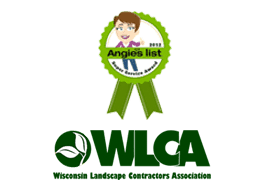
Lawn Fertilization Treatment
Milwaukee Area Fertilization Pros
Proper fertilization of your lawn will help your grass grow lush and healthy all year round. Our expert team at Best Choice Landscaping has the lawn care experience and knowledge to get the job done right.
Why Fertilize Your Lawn?
Proper lawn fertilization helps your lawn look and feel healthy, green and lush! When it comes to properly fertilizing lawns, knowledge of proper soil treatment is required.
Fertilizer is the main source of essential nutrients and minerals grass needs to grow healthy and beautiful. Though these substances can be found in soil, water and sunlight, varying climate or weather conditions greatly affect the growth of your commercial or residential lawn.
In places like Milwaukee where the grass is dormant for a good part of the year, lawn fertilization and treatment is a must. Its primary purpose is to supply the needed amount of nutrients to plants and keep away the weeds.
Equipped with adequate training, skills, and lawn care experience, Best Choice will help you to maintain a beautiful and healthy lawn!
The Right Fertilization Combination for Your Home or Business
We offer a variety of different treatment options; from one time broadleaf weed application to our full season lawn care program. Our full season plan includes several fertilization applications, including a treatment for pre-emergent crabgrass control and three liquid broadleaf applications.
Commercial lawn? Residential lawn? We’ll create a custom lawn treatment program to provide you with the best lawn care possible. We also offer mosquito control options to keep your yard pest-free!
A beautiful and healthy lawn depends on how well it’s maintained. There are plenty of factors affecting lawn growth: water, sunlight, carbon dioxide, oxygen respiration, and of course, lawn fertilization.
DIY Fertilization Do’s and Dont’s
Believe it or not, lawn fertilization is a science. If you don’t follow the proper procedure, you risk over or under fertilizing—and quite possibly damaging your lawn! We know many homeowners attempt fertilizing their lawns themselves, so we offer some do’s and don’ts below.
When you’re ready to pass off the task to a professional team, we’re happy to help!
DO
- Test your soil – Have a sample of your lawn’s soil lab-tested to find out the pH balance and nutrients required. This is crucial for finding the right combination of fertilizer and treatment for your lawn.
- Fertilize at the correct time – Make sure you fertilize during the correct times of year as well as in the right weather conditions. Don’t fertilize in major humidity or after the spring growth spurt. Never fertilize more than four times a year.
- Invest in a quality spreader – Purchase a quality spreader that will evenly and adequately spread your fertilize in your lawn. Take time to maintain your spreader for longevity.
DON’T:
- Over-fertilize – Don’t over-fertilize your property as this may damage or even kill your lawn! You also don’t want to risk fertilizer seeping into the ground and entering the groundwater supply.
- Under-fertilize – Don’t under-fertilize as you may not see the results you were hoping for. Under-fertilization may also cause damage to your property as your grass isn’t protected from certain diseases and other lawn care issues.
- Guess how much you need – Measure your yard to ensure you buy the correct amount of fertilizer. You don’t want to run out of fertilizer and excess fertilizer can be difficult to dispose of.
Follow these do’s and don’ts for a healthy and beautiful lawn! If you’d prefer to take the stress out of lawn fertilization, consider hiring a professional team. Contact Best Choice Landscaping. We have years of experience and a true passion for great lawn care.
Our Service Area
We proudly service Milwaukee County, Waukesha County, Southern Ozaukee County, and Northern Racine County. Call us today to book your lawn fertilization and treatment 414-897-7922.


